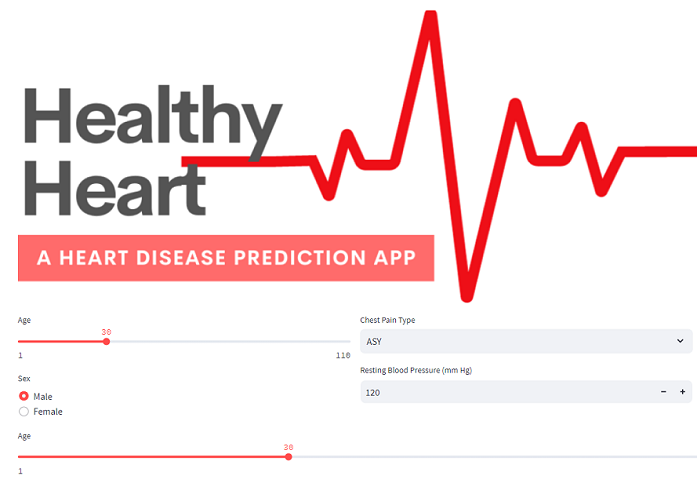- Stakeholder: Zephyr Healthcare Solutions
- Business Case: As a newly appointed lead of the data analytics team at Zephyr Healthcare Solutions, my team has been tasked with enhancing the company’s diagnostic capabilities through advanced predictive modeling techniques for Heart Disease.
Project Details
The goal is to build a robust machine learning model using various algorithms to accurately predict the presence of heart disease based on relevant health parameters.
The model is trained on a dataset containing various features related to cardiovascular health. The webapp:(https://healthy-heart.streamlit.app/) is built using streamlit.
Project Requirements
Data Collection and Cleaning:
- Obtain a comprehensive dataset from reliable sources, such as the UCI Machine Learning Repository, and ensure data integrity.
- Apply the CRISP-DM process including using data cleaning techniques to remove inconsistencies, missing values, and outliers.
- Document the data collection and cleaning process for transparency and reproducibility
Exploratory Data Analysis:
- Conduct thorough exploratory data analysis to identify patterns and relationships between different health parameters and the presence of heart disease.
- Implement machine learning models for binary classification.
- Create informative visualizations, statistical summaries, and interactive charts to effectively communicate key insights.
- Determine feature importance and fine-tune the model using hyperparameter tuning.
Iterative Approach to Modeling:
- Utilize advanced machine learning techniques, including various classification algorithms, to identify significant predictors of heart disease.
- Develop and compare at least five models for heart disease prediction.
- Clearly document the methodology and choice of evaluation metrics for each model.
Recommendations and Policy Implications:
- Based on the analysis, provide actionable recommendations for individuals, healthcare professionals, and policymakers to promote heart health and prevent cardiovascular disease.
- Propose strategies to improve heart health awareness, access to healthcare, and lifestyle modifications.
- Articulate the potential impact of the analysis on public health outcomes.
Documentation and Codebase:
- Provide comprehensive documentation explaining the methodology, data sources, and analytical techniques used in the project.
- Ensure the codebase is well-documented and organized to facilitate easy understanding, replication, and further development.
- Adhere to best practices for code readability, efficiency, and maintainability.
Reproducibility and Open Access:
- Structure the repository to enable easy replication of the analysis and verification of results.
- Include clear instructions on obtaining and preprocessing the necessary data for the analysis.
- Ensure the repository and its contents are publicly accessible, promoting open access to the analysis, data, and code.
Collaboration and Feedback:
- Welcome contributions from the open-source community to enhance the project with bug fixes, enhancements, and additional analyses.
- Provide guidelines and instructions for contributing, ensuring a smooth collaborative process.
- Engage with users, address inquiries, and consider feedback to improve the repository and its analysis.
- Respect privacy regulations and data protection policies while handling sensitive information.
- Safeguard the anonymity of individuals and organizations involved in the dataset.
- Clearly communicate any limitations or ethical considerations associated with the analysis.
By adhering to these project requirements, the “Healthy Heart Prediction” repository will serve as a reliable and accessible resource for researchers, healthcare professionals, and policymakers interested in cardiovascular health.

